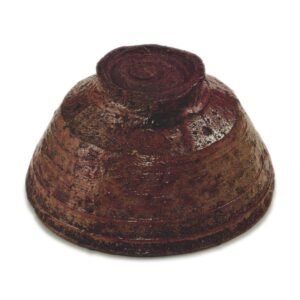

Height: 7.0-7.5cm
Diameter: 14.3-14.5cm
Outer diameter of foot ring: 6.1cm
Height of foot ring: 1.2cm
This is one of the three tea bowls known as the “Kugibori Sanwan” (three tea bowls with nail-carved designs), along with the “Aki no Yama” and the “Saga no Aki”.
Kugibori is a relatively rare type of Iroha ware, and apart from two other bowls, the “Aki no Yama” is the only one included in the “Taisho Meiki Kan” (A Guide to Famous Tea Bowls from the Taisho Period).
There is a spiral pattern inside the foot ring that looks as if it has been carved with a nail, and this is one of the highlights of the piece. The quality of the spiral pattern can be said to determine the overall quality of the nail-carved tea bowl. In general, the better ones are those in which the lines of the nail carving slowly wind around, almost awkwardly. There are several Iraho bowls that are currently referred to as famous bowls, and they all have a very similar style, so it is thought that they were probably all made by the same artist.
The clay is a soil with a high iron content and small grains of sand, and the so-called Iraho glaze covers the inside and outside of the piece in a thin layer that gives it a very irritating feel, but there are places where it has turned blue like moss and places where it has turned red like scorch marks, and even though it is humble, it shows a kind of flamboyance. In particular, Ryohiko has a stronger reddish hue than the other autumn mountain and other nail carvings, and it is a work of great depth.
In terms of its great depth, Ryohiko is probably the best of all the Ryuwan. In particular, the sharpness of the rim and the side cut from the foot to the waist is the most distinctive feature of this tea bowl. Also, the fine lines of the pull-rim around the body are larger and stronger than those of other pieces. There is one rather large stone rim on the foot rim, covered with a dark greenish-brown glassy glaze, adding a further complex aspect, and there are also several other stone rim marks of various sizes. The upper foot rim is also relatively large, and is roughly hewn and strong. It is almost as if the artist has forgotten the intention behind this, and there is no trace of it. Even the kugibori carving seems to be done without any care. For Iraho, who is rather flexible in contrast to the boldness of the well, this is a surprisingly bold tea bowl.
The overall appearance is tinged with a bluish hue, and the red glaze is visible around the whorl-shaped central tea pool. In addition, the interior is decorated with numerous grains of stone, large and small, including the stone that protrudes from the outside to the inside, as well as fine lines of pulling and five eye marks. Also, a slightly funnel-shaped area can be seen around the rim.
In Toda Rogen’s “Gogaku-shu” (Collected Works of Later Scholars), it is written, “Kugibori Irahoko, also called Ryohiko, owned by Motoo Tsukasa, owned by Kusama, and then by Kurigai and two others through a bidding war, and now owned by Nada Yamao (Kawachiichi). Kawachiichi) and the other is owned by Mr. Hirase, and there is a large stone next to the tea bowl. The accompanying letter from Ryohiko says, “The two bowls on the right are called Ryuko, but Ryohiko is the best of the two.” Whether you choose the Akinoyama or Ryohiko will depend on your personal preference.
It was passed down from Otsu Ryohiko to the Kusama family in Osaka, and then in 1884 it came into the possession of the Yamamura family in Nada, but it is now owned by a person in Kanazawa.
The inner box is black lacquered. On the front of the lid is the gold-painted character “Iraho Ryohiko”, but the author is unknown.



